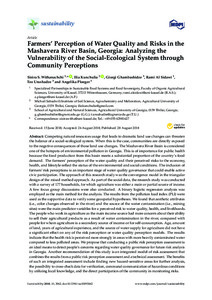| dc.date.accessioned | 2018-09-25T12:06:19Z | |
| dc.date.available | 2018-09-25T12:06:19Z | |
| dc.date.issued | 2018-08-28 | |
| dc.identifier.issn | 2071-1050 | |
| dc.identifier.uri | urn:nbn:de:hebis:34-2018092556451 | |
| dc.identifier.uri | http://hdl.handle.net/123456789/2018092556451 | |
| dc.description.sponsorship | Gefördert durch den Publikationsfonds der Universität Kassel | |
| dc.language.iso | eng | |
| dc.rights | Urheberrechtlich geschützt | |
| dc.rights.uri | https://rightsstatements.org/page/InC/1.0/ | |
| dc.subject | environmental pollution | eng |
| dc.subject | binary logistic regression analysis | eng |
| dc.subject | water quality governance | eng |
| dc.subject | sustainability | eng |
| dc.subject | integrated model of risk assessment | eng |
| dc.subject.ddc | 630 | |
| dc.title | Farmers’ Perception of Water Quality and Risks in the Mashavera River Basin, Georgia: Analyzing the Vulnerability of the Social-Ecological System through Community Perceptions | eng |
| dc.type | Aufsatz | |
| dcterms.abstract | Competing natural resources usage that leads to dramatic land use changes can threaten the balance of a social-ecological system. When this is the case, communities are directly exposed to the negative consequences of those land use changes. The Mashavera River Basin is considered one of the hotspots of environmental pollution in Georgia. This is of importance for public health because the food production from this basin meets a substantial proportion of the country’s food demand. The farmers’ perception of the water quality and their perceived risks to the economy, health, and lifestyle reflect the status of the environmental and social conditions. The inclusion of farmers’ risk perceptions is an important stage of water quality governance that could enable active civic participation. The approach of this research study was the convergence model in the triangular design of the mixed method approach. As part of the social data, the research study was conducted with a survey of 177 households, for which agriculture was either a main or partial source of income. A few focus group discussions were also conducted. A binary logistic regression analysis was employed as the main method for the analysis. The results from the pollution load index (PLI) were used as the supportive data to verify some geospatial hypotheses. We found that aesthetic attributes (i.e., color changes observed in the river) and the source of the water contamination (i.e., mining sites) were the main predictor variables for a perceived risk to water quality, health, and livelihoods. The people who work in agriculture as the main income source had more concern about their ability to sell their agricultural products as a result of water contamination in the river, compared with people for whom agriculture is a secondary source of income or for self-consumption. Age, amount of land, years of agricultural experience, and the source of water supply for agriculture did not have a significant effect on any of the risk perception or water quality perception models. The results indicate that the health risk is perceived more strongly in areas with more heavily contaminated water compared to less polluted areas. We propose that conducting a public risk perception assessment is an ideal means to detect people’s concerns regarding water quality governance for future risk analysis in Georgia. Another recommendation of this study is an integrated model of risk assessment that combines the results from a public risk perception assessment and a technical assessment. The benefits of such an integrated assessment include finding new hazard-sensitive areas for further analysis, the possibility to cross-check data for verification, communal communication of hazardous conditions by utilizing local knowledge, and the direct participation of the community in monitoring risks. | eng |
| dcterms.accessRights | open access | |
| dcterms.bibliographicCitation | In: Sustainability. - Basel : MDPI. - 2018, 10 (9), 3062, 1-26 | |
| dcterms.creator | Withanachchi, Sisira Saddhamangala | |
| dcterms.creator | Kunchulia, Ilia | |
| dcterms.creator | Ghambashidze, Giorgi | |
| dcterms.creator | Al Sidawi, Rami | |
| dcterms.creator | Urushadze, Teo | |
| dcterms.creator | Ploeger, Angelika | |
| dc.relation.doi | doi:10.3390/su10093062 | |

